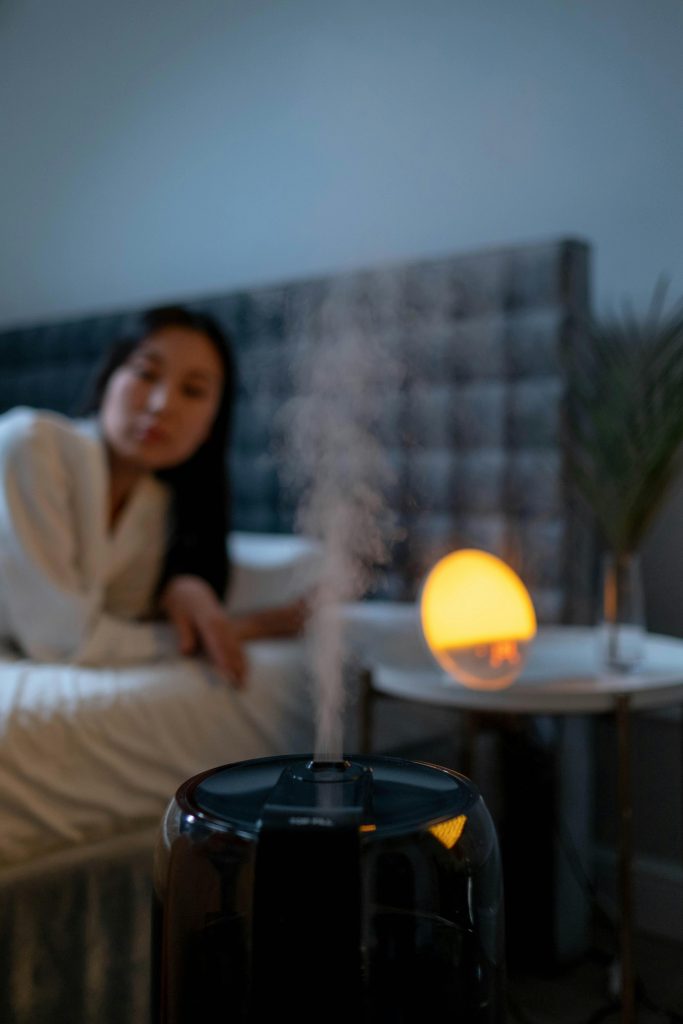As the winter months approach, most of us brace ourselves for dry air that causes chapped lips, dry skin, and scratchy throats. But what if I told you there’s a simple way to bring comfort and moisture back into your home during this chilly season? The answer lies in optimizing your humidifier in winter. In this guide, I’ll walk you through everything you need to know about using the right humidifier settings in winter, ensuring your home stays cozy and healthy throughout the cold months.
Why Your Home Needs a Humidifier This Winter
Winter is notorious for bringing down indoor humidity levels. The cold air outside doesn’t hold much moisture, and when we heat our homes, the warmth dries the air even further. This combination can wreak havoc on your health, skin, and even your furniture.
I remember waking up one winter morning with a dry throat, irritated eyes, and cracked lips. At first, I thought it was just the cold weather. But after a few days of this discomfort, I realized the culprit was dry indoor air. A friend recommended a humidifier, and the difference it made was incredible. Suddenly, the air felt fresher, my skin was less irritated, and I was able to sleep soundly again.
Dr. John Smith, Respiratory Specialist: “Maintaining proper humidity levels during winter can significantly reduce respiratory irritation. Dry air can aggravate conditions such as asthma and allergies, making a humidifier a valuable tool in winter wellness.

Why is indoor humidity lower in winter?
The science behind winter air and indoor humidity is pretty simple: cold air holds less moisture than warm air. When outdoor temperatures drop, the air becomes dry. Then, when that cold air enters your home and is heated, it loses even more of its already low moisture content, making your indoor environment feel like a desert.
What is Humidity and Why It Matters?
Humidity is the amount of water vapor in the air. Maintaining an optimal humidity level in your home, especially during winter, is vital for your health and comfort. Too little humidity, and you’ll experience dry skin, irritated sinuses, and breathing issues. Too much humidity can lead to mold and mildew growth.
Impact of Low Humidity on Health and Your Home
Low humidity doesn’t just dry out your skin and throat; it can also increase your chances of catching colds and the flu. Dry air makes it harder for your nasal passages to filter out viruses, leaving you more vulnerable. Low humidity can also take a toll on your home by causing wooden furniture to warp, paint to peel, and even electronic devices to malfunction due to static electricity buildup.
Should You Use a Humidifier in the Winter?
The question “Should I use a humidifier in winter?” is one that many people ask. The short answer is: absolutely! Using a humidifier in winter can significantly improve your overall comfort and health.

Benefits of a Humidifier in Winter
One of the key benefits of a humidifier in winter is that it helps balance the moisture in the air, which in turn provides relief from dry skin and irritated sinuses. It can also help reduce the chances of catching colds, as viruses tend to thrive in dry conditions. Here’s a closer look at the top benefits:
Dr. Michael Roberts, Environmental Health Scientist: “When the air becomes too dry, viruses and bacteria can spread more easily. Using a humidifier to maintain optimal humidity levels in winter can reduce the transmission of airborne infections, making your home healthier.”
- Improved Respiratory Health: With more moisture in the air, your nasal passages and throat will feel less irritated, making it easier to breathe, especially during sleep.
- Better Skin Hydration: Say goodbye to cracked lips and flaky skin. Adding moisture to the air helps your skin retain its natural hydration.
- Protect Your Home: Wooden furniture, musical instruments, and floors all benefit from balanced humidity levels. You’ll notice less warping and cracking.
- Improved Sleep: Moist air is more comfortable to breathe, which means fewer interruptions to your sleep due to coughing, dry throats, or nasal congestion.

What is the best setting for a humidifier in the winter?
What’s the Ideal Humidity Level in Winter?
The ideal indoor humidity level in winter is between 30-50%. Anything lower, and the air becomes too dry. Higher than 50%, and you risk mold and mildew growth. To monitor your home’s humidity levels, invest in a hygrometer—an inexpensive tool that measures moisture levels in the air.
- For mild winter days: Aim for 40% to 45% humidity.
- On colder days (below freezing): Lower it to around 30% to prevent condensation on windows and walls.
How to Adjust Your Humidifier Settings
Different factors, such as the outdoor temperature, the size of your room, and your personal comfort, will determine how often and how high you need to set your humidifier in winter. A general rule of thumb is to start with a lower setting and increase gradually until you reach the desired comfort level.
Monitor and Adjust Based on Temperature
As the outside temperature drops, indoor humidity can cause condensation on windows, which can lead to mold and dampness. On very cold days, lower the humidity setting to avoid this issue. For example:
- Above 20°F (-6°C): 35% to 40% humidity.
- Between 10°F to 20°F (-12°C to -6°C): 30% to 35% humidity.
- Below 10°F (-12°C): Keep it around 30% or lower.
Set a Timer for Consistency
Consider setting a timer if your humidifier has this option. Running it intermittently can help maintain stable humidity levels without over-humidifying the space.

How to Choose the Right Humidifier for Winter
Choosing the right humidifier for winter is essential if you want to make the most of its benefits. There are several types to choose from, and each has its pros and cons depending on your home and personal preferences.
Types of Humidifiers
- Warm Mist vs. Cool Mist: Warm mist humidifiers boil water before releasing it as steam, which can help kill bacteria and allergens. Cool mist humidifiers, on the other hand, release a cool vapor and are often considered safer, especially in homes with children or pets.
- Ultrasonic Humidifiers: These use ultrasonic vibrations to create a fine mist. They are usually very quiet, making them ideal for bedrooms and nurseries.
- Evaporative Humidifiers: These work by using a fan to blow air over a wet wick, evaporating the water into the air naturally. They’re energy-efficient and good for large spaces.
Room Size Consideration
When choosing a humidifier in winter, consider the size of the room you’ll be using it in. Smaller rooms like bedrooms require smaller units, while larger spaces like living rooms or open-plan areas may need a humidifier with a bigger tank and more output.
Noise Levels and Maintenance
Another thing to consider is how much noise a humidifier makes. If you’re a light sleeper, look for a quieter model. Regular maintenance is also important—look for a model that’s easy to clean and has replaceable filters.
The Best Humidifiers for Winter: Top Picks
There are countless humidifiers on the market, and finding the right one can feel overwhelming. Below are some top choices for a humidifier in winter that I’ve tried and recommend.
Top Models to Consider
- Levoit Classic 200: A cool mist humidifier that’s quiet, budget-friendly, and ideal for medium-sized rooms.
- Honeywell HCM350W: Best for large spaces, this evaporative humidifier is known for its durability and easy cleaning.
- Pure Enrichment MistAire: A sleek and effective cool mist humidifier, perfect for smaller rooms.
I remember going through three different humidifiers one winter before settling on the Honeywell HCM350W. It was the only one that kept my living room comfortable without needing constant refills, and it was surprisingly easy to clean.
Humidifier Maintenance: Tips for a Long-lasting Device
Keeping your humidifier in winter running efficiently requires regular maintenance. Without proper care, your humidifier can become a breeding ground for mold and bacteria, which can be harmful to your health.
Daily and Weekly Maintenance
Daily maintenance involves refilling the water tank with clean, filtered water. Weekly, you should clean the humidifier with mild soap and water to prevent mineral buildup and bacteria growth.
Using Filtered Water vs. Tap Water
While some humidifiers claim to work well with tap water, using filtered or distilled water can prolong the life of your device and reduce the need for frequent cleanings. This is especially important in areas with hard water, as mineral deposits can accumulate quickly.
Stay Healthy With Optimal Humidifier Settings
Whether you’re dealing with dry skin, frequent colds, or just want a more comfortable home, the right humidifier settings in winter can make all the difference. By choosing the right device, maintaining optimal humidity levels, and keeping your humidifier clean, you’ll enjoy a healthier, more comfortable winter season.
So, as the temperatures drop and the air gets drier, make sure your home stays cozy by using a humidifier in winter to keep the air perfectly balanced. You’ll feel the difference almost immediately, and your skin, lungs, and even your furniture will thank you!
